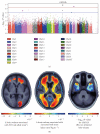Neuroimaging measures as endophenotypes in Alzheimer's disease
- PMID: 21547229
- PMCID: PMC3087508
- DOI: 10.4061/2011/490140
Neuroimaging measures as endophenotypes in Alzheimer's disease
Abstract
Late onset Alzheimer's disease (AD) is moderately to highly heritable. Apolipoprotein E allele ε4 (APOE4) has been replicated consistently as an AD risk factor over many studies, and recently confirmed variants in other genes such as CLU, CR1, and PICALM each increase the lifetime risk of AD. However, much of the heritability of AD remains unexplained. AD is a complex disease that is diagnosed largely through neuropsychological testing, though neuroimaging measures may be more sensitive for detecting the incipient disease stages. Difficulties in early diagnosis and variable environmental contributions to the disease can obscure genetic relationships in traditional case-control genetic studies. Neuroimaging measures may be used as endophenotypes for AD, offering a reliable, objective tool to search for possible genetic risk factors. Imaging measures might also clarify the specific mechanisms by which proposed risk factors influence the brain.
Figures

References
-
- Bergem ALM, Engedal K, Kringlen E. The role of heredity in late-onset Alzheimer disease and vascular dementia: a twin study. Archives of General Psychiatry. 1997;54(3):264–270. - PubMed
-
- Gatz M, Pedersen NL, Berg S, et al. Heritability for Alzheimer’s disease: the study of dementia in Swedish twins. Journals of Gerontology. Series A. 1997;52(2):M117–M125. - PubMed
-
- Gatz M, Reynolds CA, Fratiglioni L, et al. Role of genes and environments for explaining Alzheimer disease. Archives of General Psychiatry. 2006;63(2):168–174. - PubMed
-
- Goate A, Chartier-Harlin MC, Mullan M, et al. Segregation of a missense mutation in the amyloid precursor protein gene with familial Alzheimer’s disease. Nature. 1991;349(6311):704–706. - PubMed
-
- Sherrington R, Rogaev EI, Liang Y, et al. Cloning of a gene bearing missense mutations in early-onset familial Alzheimer’s disease. Nature. 1995;375(6534):754–760. - PubMed
LinkOut - more resources
Full Text Sources
Other Literature Sources
Research Materials
Miscellaneous

